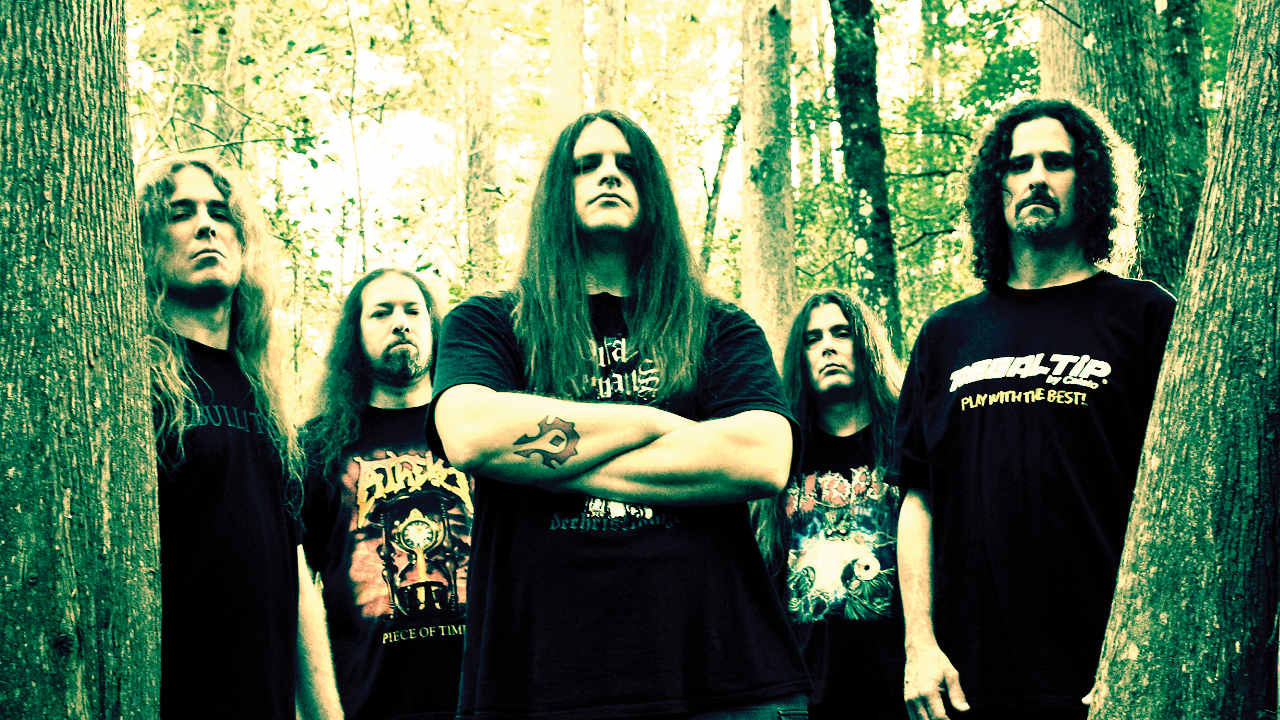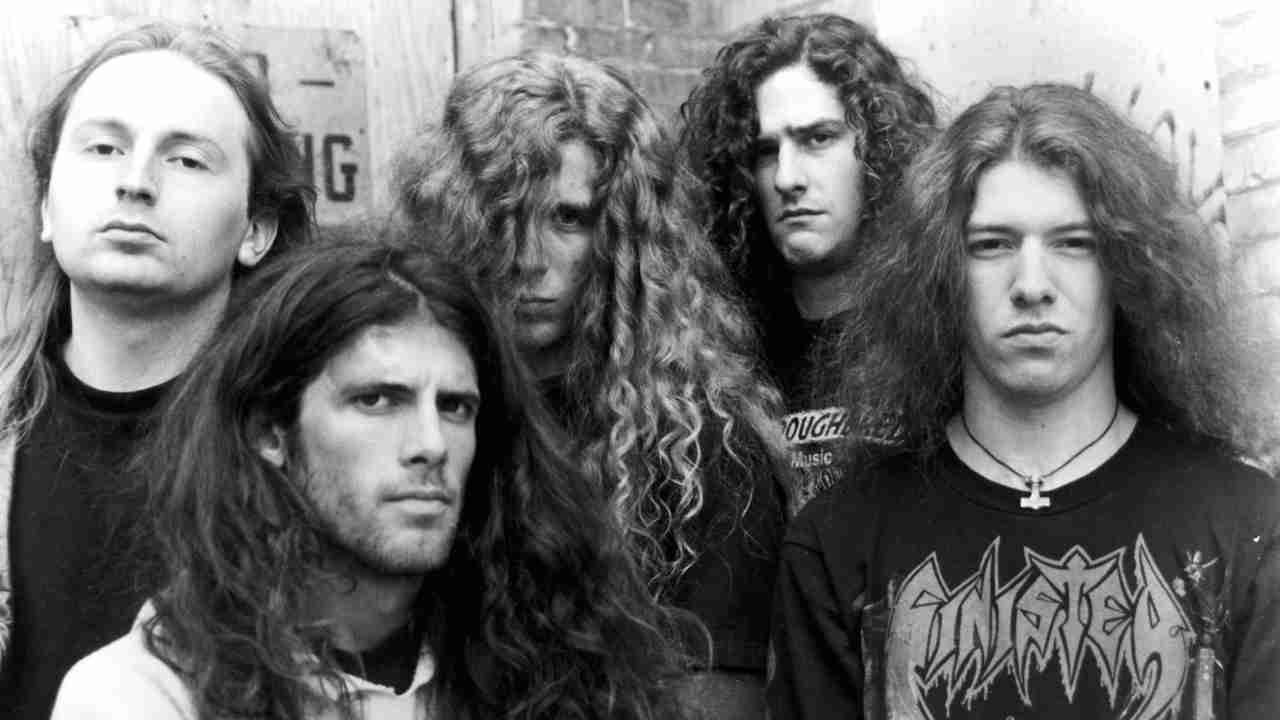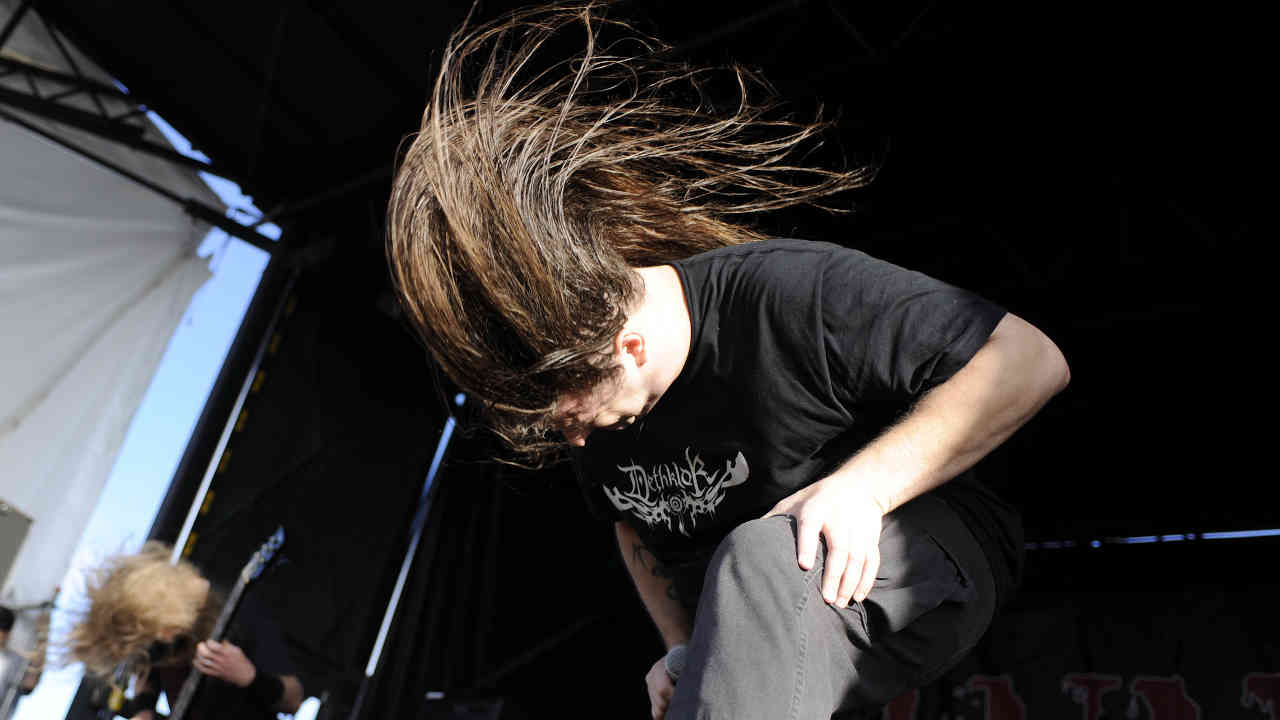
Cannibal Corpse are the most successful death metal band ever. Since forming in Buffalo, New York in the late 1980s, they’ve sold more than a million albums, generated plenty of mainstream controversy and even impressed Jim Carrey enough to appear in Ace Ventura: Pet Detective. In 2012, as the band prepared to release their 12th album Torture, guitarist Alex Webster sat down with Metal Hammer to look back at a career drenched in blood, guts and provocation.
As time marches on, it becomes harder and harder to recall a time when our heavy music still had the ability to startle, shock and disturb. Back in the 80s, when most of what we regard as extreme metal was merely a wicked glint in the eye of guitar-wielding demons yet to be spawned, the lines between now well-established subgenres like thrash, black metal and death metal were not so much blurred as non-existent.
The true horror of metal at its darkest and most intense was only just beginning to reveal itself, and for those who allied themselves to the genre’s nascent dark side, the incremental discovery of what was possible and how far into the depths of the sonic abyss our favourite musicians could take us was an astonishing and compelling rollercoaster ride with no clear destination to anticipate. Back then, we embraced the unknown and revelled in our music’s pointed and purposeful otherness, as those who rejected heavy music recoiled in ignorant fear. We looked to the daring and the dastardly to refine and define what it meant to be brutal. And that’s where the mighty Cannibal Corpse came in...
“When we got going, there were only a few other bands that you’d really call death metal,” recalls founder member and bassist Alex Webster. “Possessed, Death and Morbid Angel were around and there were thrash bands that we liked that were borderline death metal with that darker riffing sound, like Dark Angel and early Kreator and Sodom stuff. We loved early black metal like Venom and Bathory too. It was kinda like a tree. It all starts from the same root and the branches move out and get farther and farther away from each other. We were far from being the first, but it was always death metal and it was always gore.”
Today, Cannibal Corpse are now firmly established as both the biggest DM band of all time and the ultimate expression of extreme music as a natural bedfellow of horror cinema and literature. Renowned for their depraved and disturbing lyrics and foul, censor-baiting artwork, the band have never strayed from a proudly subversive and ugly creative path, becoming a benchmark for brutal metal and gore-splattered mischief via a stream of consistently impressive studio albums.

Back in the late 80s, however, DM was still in its infancy and it took a brave label to invest time and money into a band that had such a fervently unpalatable agenda. Thankfully, original Cannibal Corpse frontman Chris Barnes had made a helpful contact or two while working in a local record shop and it was through his connections that his band found them- selves in negotiations with the legendary Brian Slagel and his long-admired Metal Blade imprint. Signed in 1989, Cannibal Corpse have remained with the label ever since; an extraordinary and unique relationship in a frequently uncertain and turbulent industry.
“That connection between Chris’s old boss and Mike Faley at Metal Blade was how we got our foot in the door,” recalls Alex. “That helped them notice us and once they noticed us they liked what they heard. When Brian [Slagel] saw the songtitles he was like, ‘Oh well, we should just sign this band! Those are crazy songtitles!’ We’ve always had a great personal connection with all the people at the label. They won’t hire somebody unless they’re into metal. They take pride in what they do and genuinely love metal. They’ve treated us well; we never saw a reason to leave. We’ve got to be one of the only bands that’s put out 12 records on the same label!”
Cannibal Corpse released their debut, the heavily thrash-tinged Eaten Back To Life, in August 1990. Recorded at Morrisound Studio in Tampa, Florida, it offered a blistering and frenzied amalgam of the band’s influences married to lyrics and imagery that eschewed thoughts of Satan in favour of a horror-inspired approach. Songs like Shredded Humans, The Undead Will Feast and A Skull Full Of Maggots were custom-built to appeal to the huge subset of the metal community that loved Stephen King and Jack Ketchum, The Texas Chainsaw Massacre and Evil Dead, Lovecraft and Poe.
As primitive and even juvenile as they may first have appeared, Cannibal Corpse – who initially featured Chris and Alex alongside drummer Paul Mazurkiewicz and guitarists Bob Rusay and Jack Owen – were tapping into something far deeper and longer-lasting. The kings of gore were installed on their throne; leading lights in a DM scene that was growing fast. By the time they hit the road in support of 1991’s Butchered At Birth album, Cannibal Corpse were unstoppable.
“On Eaten Back To Life we didn’t really tour,” explains Alex, “but we did a few shows around the Buffalo area and went to NYC, Montreal, Toronto, Pittsburgh etc, but then we went over to Europe in ’91 for Butchered At Birth and saw this great reaction from all these people on the other side of the ocean. We were like, ‘Wow, all these people know who we are!’ We were getting two or three hundred people a night at these shows, which was really great for a band with only two albums out. It was a great surprise.”
Something that may not have come as quite such a huge surprise to these young miscreants as they took their murderous din across the Atlantic was that a lot of people were extremely offended by the Butchered At Birth artwork, which depicted zombies dismembering a pregnant woman. Created by Vincent Locke – the man behind most of Cannibal Corpse’s gleefully disgusting album covers – it was always destined to ruffle feathers, but when the album reached the eyes of censorious types in Germany, all hell broke loose and the band suddenly found themselves embroiled in an intense furore that eventually led to their albums being banned and, somewhat bizarrely, an intermittent legal restriction on the live performance of certain songs.
“Vince’s art was a big part of the controversy!” Alex laughs. “Especially on Butchered At Birth. We had the graphic lyrics and the cover was graphic too, so it was difficult for censors to ignore. That’s when it began in Germany. They were very sensitive to that kind of thing. I mean, honestly, it’s understandable. Look at the cover for Butchered At Birth! I get it. I understand why people find it offensive! But that was the beginning of censorship problems that we’ve had our whole career. Butchered... was censored all over the place; as far as I know we still can’t sell that cover in Germany. That cover was in everyone’s face and so when then they read the lyrics and dug a little deeper it became a case of ‘Oh my god, we’ve got stop these guys!’”
Undeterred by the horrified response they received in certain territories, Cannibal Corpse – and chief lyricist Chris Barnes in particular – made every effort to consolidate their reputation as the world’s most extreme and controversial metal band on their third album, Tomb Of The Mutilated. Again adorned with some sincerely unpleasant cover art – this time featuring a particularly gruesome act of cunnilingus – it was an album bulging with moments of stomach-churning horror, ranging from the cross-your-legs revulsion of I Cum Blood through to the provocatively over- the-top Entrails Ripped From A Virgin’s Cunt.
“Chris was in charge of the lyrics and he ran the band business at that time as well, so he knew what he was doing!” laughs Alex. “We placed no limits on him and he came up with the lyrics on his own. He’d come to us with the most vile, repugnant stuff and we’d be like, ‘Sure! Why not?’ We were trying to make the most extreme and aggressive music we could, so why not have the most antagonistic lyrics too?”
Somewhat ironically, it was Tomb Of The Mutilated that would push Cannibal Corpse ever nearer to the mainstream. Much to everyone’s surprise, the band were summoned to take part in comic actor Jim Carrey’s break- through big-screen vehicle Ace Ventura: Pet Detective. The band performed their show-stopping classic Hammer Smashed Face as Jim gurned and blundered his way through a crowd of windmilling metalheads. As a result they gained the sort of mainstream exposure that no one from the metal underground had ever even dreamed about before, let alone achieved.
“We filmed that during part of the Tomb Of The Mutilated tour,” Alex recalls. “They flew us out to Miami to film the scene and then we went back on tour and kinda forgot about it. This was before the internet and you just didn’t get updated on things the way you do now, so we were completely out of touch with them but later we all went to see the movie. It was cool! We didn’t even know if they’d kept us in there. It happened to come out a couple of months before we released [the next Cannibal Corpse album] The Bleeding and it turned out to be a hit movie, so that had to help us. On top of that, for The Bleeding, we finally got a music video for Staring Through The Eyes Of The Dead, and that had to help too because they played it on MTV a couple of times. We were on Beavis And Butt-head, being ridiculed of course, but at least it was on there! There was a lot of publicity – we’d never been so exposed. The Bleeding is still our best selling record.”

Emboldened by the success of their fourth album, not to mention an improvement in musicianship as new rhythm guitarist Rob Barrett (who replaced Bob Rusay) brought a tightness and precision to the Cannibal Corpse sound that had been conspicuous by its absence on their earlier albums, Alex and his comrades were enjoying a moment in the spotlight that few would’ve predicted given the extremity of their music.
Buoyed by their achievements, they relocated from Buffalo to the sunny climes and sandy beaches of Tampa, Florida. However, the controversy that had long dogged the band was showing no signs of dissipating and within a year of The Bleeding’s release, right-wing US senator Bob Dole was targeting the band and proclaiming them to be a threat to the moral values of a generation of young Americans. Trenchant bollocks of the worst kind, of course, but Bob Dole’s interest in censoring Cannibal Corpse and their music was a little unexpected, not least because it was so hard to imagine that any mainstream politician would be aware of death metal’s existence in the first place.
“I probably shouldn’t speculate why he singled us out, other than because we were massively offensive!” smiles Alex. “I just don’t see Bob Dole doing the research on his own, quite frankly! I suspect the Christian fundamentalist lobbyist types were responsible for all that. But if anything it just helped us! Anything that someone like that tells you not to listen to, you’re gonna want to check out, right?”
Firmly at the top of the DM heap, Cannibal Corpse were in such a strong position in the mid 90s they were even able to weather the departure of talismanic frontman Chris Barnes. While recording their fifth album, Vile, the band felt that Chris’s distinctive but limited vocal style and stubborn refusal to evolve in tandem with the music prompted them to eject him from the lineup; a brave move, particularly considering how popular the singer was with the band’s fanbase. Fortunately, as Alex explains, the perfect replacement was already waiting in the wings. Enter George ‘Corpsegrinder’ Fisher...
“George was part of the Tampa scene although he was living between Baltimore, where his family was, and Tampa with [DM veterans] Monstrosity,” says the bassist. “It was around October ’95 and we were recording with Chris and it wasn’t working out. Chris went away for a few weeks to tour with Six Feet Under and we decided to kick him out and get George. So I called him up and he came down and he was the man! He was exactly what we wanted. If you listen to bands like Kreator and Dark Angel, they have that really rapid-fire vocal delivery and George was able to do that in a DM way. We wanted the Tom Araya of DM and we found him!”
A few petulant complaints from disillusioned Chris Barnes fans aside, Corpsegrinder was swiftly accepted by the Cannibal Corpse faithful, not least because Vile was such a potent and unrelenting record that brilliantly showcased his talents. In 1997, another lineup change added yet more fuel to the band’s fire as Rob Barrett left and was replaced by ex-Nevermore wunderkind Pat O’Brien.
“Pat had a massive impact, “ says Alex. “He has that shredding firepower that we’d never had before. You have to be pretty special to play next to Jeff Loomis!”
Despite their rude collective health, however, there is no denying that Cannibal Corpse were about to enter a more sobering era, wherein more easily marketed black metal bands dominated column inches and traditional DM bands struggled to be heard. From 1998’s Gallery Of Suicide album onwards, Cannibal Corpse simply put their noses to the grindstone and took care of business.
“Yeah, from Gallery... to The Wretched Spawn in 2004 we were still doing quite well but it was a different time,” Alex concedes. “Our tours were successful and we were still able to make a living, but Bloodthirst [released in 1999], for instance, which I think is one of our best records, is also our lowest-selling album! Overall, DM was not a high point publicity and popularity-wise. But we stayed consistent. Every one of the records represents our best effort at that time and I’m proud of them all.”
Despite being the first DM band to sell over a million albums worldwide, Cannibal Corpse have rarely been acknowledged for their immense influence on the extreme metal scene in general, but recent years have been kinder to their reputation as a new generation of bands have discovered and redefined the joys of playing insanely brutal metal. Any aspiring young metal musician who embraces notions of speed, aggression and mindbending technicality must owe a debt of gratitude to Cannibal Corpse and their legacy. The band themselves also seem to have been revitalised by recent developments in the extreme metal realm, as the creative highs of 2006’s Kill and 2009’s Evisceration Plague – both bolstered by the returning Rob Barrett, who replaced Jack Owen in 2005 – have noisily and compellingly demonstrated.

“We were very aware of how things changed back in our favour again and very happy that we were still around to enjoy some of the benefits!” says Alex. “In 2006 we did a tour called Sounds Of The Underground, with Job For A Cowboy and Black Dahlia Murder, and seeing all these younger fans being interested in this kind of stuff, and now bands like Whitechapel and Suicide Silence too, that’s great. Some of that stuff is not exactly DM, but it’s definitely closely related and if a guy in JFAC wears a Morbid Angel shirt, the fans are gonna investigate who Morbid Angel is. That’s so cool. Our crowds’ ages stretch from 15 to 50 and maybe even a little beyond that. It makes me happy for my band but also for DM in general. We’re here to stay!”
As they prepare to unleash their 12th album, Torture, Cannibal Corpse are both revered veterans and a highly credible, vibrant musical force. Not many bands survive for as long as these guys have, but not only have they weathered over two decades of gruelling active service, but their passion for making music that plumbs the depths of depravity while crushing every skull within blood-spurting distance shows no signs of diminishing. DM is about good times, great music and gallons of gore shared with like- minded friends. And right now, just as it ever was, no one does it better than Cannibal Corpse.
“You can listen to whatever you want, have a broad musical taste, but you should never feel that you need to grow out of listening to or playing death metal,” grins Alex. “I feel like some people are like ‘Oh, I’m in my 30s now so maybe I should start listening to serious music now...’ Goddamn it, death metal is serious music and you can listen to it until you’re 80 years old! And I will. I know I’m gonna love this music my whole life and I know there’s a lot of people who feel the same way. We like all different kinds of metal, but death metal is still our favourite. I don’t see that changing!”
Originally published in Metal Hammer issue 226







